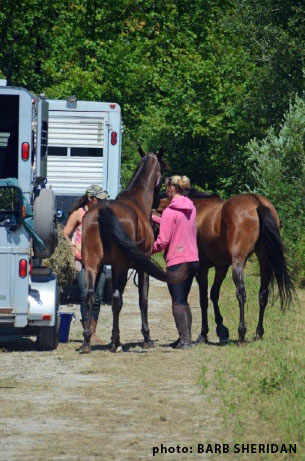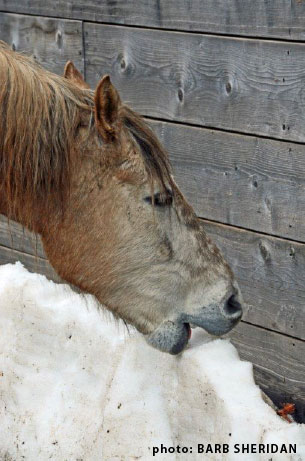ARCHIVE EQUINE NEWS STORIES
| Current news is available at TheHorsePortal.ca, Equine Guelph's online learning platform for practical, quick learning. Given the vast amount of information on horse health and welfare, Equine Guelph has archived its past news articles from 2002-2020. They are listed below, along with a search function available to find specific healthcare topics. | |
When Disaster Strikes, Plan to be Prepared March 2014
By Barbara Sheridan
Ice storms, blizzards, floods, or tornadoes - it seems that over the past few years, we’ve seen them all. Disasters often strike without warning as demonstrated recently by the notable December ice storm that wreaked havoc on hundreds of thousands residents in Ontario, the Maritimes, and the northeastern U.S. with downed tree limbs and power lines. Many were without power for days, while for others it was weeks, which meant no heat, hydro or water.
No one is immune from the possible effects of a disaster, no matter what the season, but preparing ahead of time and having an emergency plan in place before disaster strikes will help to keep our horses safe and out of harm’s way.
Plan it Out

Being aware of the possible risks in your region is the first step toward preparing for any possible disaster that has the potential to cause a short term or long term disruption to you, your family and your animals. Is your area prone to flooding? What about tornadoes or blizzards? If the roads are closed, how do you get food to your horses?
The next step is to plan for any possible extended disruption of services. Authorities usually recommend having at least two weeks supply of feed/hay on hand, and kept stored in a dry area. Top off all water tanks and buckets before an impending storm, and store additional water in plastic trash cans secured with lids in a safe place. Consider having well-maintained generators on hand to provide emergency power, and have enough fuel to keep them running for several days. Always keep an up-to-date emergency care kit that includes vetwrap, bandages, medications, flashlights, batteries, etc. Having an envelope set aside with emergency cash, the amount depending on your budget and needs will also come in handy for times such as these.
In addition to Mother Nature’s list of natural disasters, you should also consider other potential dangers such as wildfires or the possibility of manmade emergencies including gas leaks or propane spills. Many times, these result in evacuation with very little notice.
In the case of an evacuation, while you might be able to take the family pet along with you to a hotel, it’s not the time to start calling around to find a safe location to move your horses. Prearrange an evacuation site for your horses and map out primary and secondary routes in advance. Develop a buddy system with friends and neighbouring barns. Don’t hesitate to ask for help when the time comes. Also, make sure your horses are trained to easily load and unload from a trailer. If evacuation is not possible, decide where on the property to safely store your horses. Micro chipping, branding, or tattooing, along with registration with online identification agencies, provides a permanent form of animal identification. As an alternative, ensure that your horses are equipped with some form of identification such as a halter tag, neck collar, or leg tag that contains your contact information, should you have to leave them behind.
Human Safety Comes First
In the case of a natural or man-made disaster, it’s important that the safety of humans come first, says District Chief Victor MacPherson of the Adjala-Tosorontio Fire Department. “Make sure that you and your family are safe before assisting your animals,” he says. “In the case of a fire, this is where emergency preparedness comes into play. If the barn is on fire, what do you do? What do you do with your livestock? My advice is, if it’s safe to do so, try to get them out. However, if you bring them out of the barn and just turn them loose, most likely the horses will try to run back into the barn. That’s where their haven is; what they consider to be their safe place. People should have a location in mind ahead of time to safely keep them together, such as a field or another barn far away from the fire.”
MacPherson recalls an incident with a large grass fire that claimed nearly 200 acres in the Adjala-Tosorontio area in July 2012. “The grass fire was moving aggressively towards a certain farm area, and was a heavy fuel load [had a lot to burn], with a lot of smoke,” he says. >em>“Smoke can be just as dangerous as fire because it’ll spook the horses. With the help of the property owner, we were successful in moving them out to a safer place.”
As is often the case in an emergency when people call 911, firefighters are usually the first responders to the scene. Because of this, many firefighters are now receiving training in how to handle animals in emergency situations. Last year, the Adjala-Tosorontio Fire Department held a Technical Large Animal Emergency Rescue (TLAER) course for first responders and animals owners. Deborah Chute, owner and operator of Laurenwood Stables and a volunteer firefighter with the Adjala-Tosorontio Fire Department, helped co-ordinate this course after seeing the need for such a training program.
“I first started thinking about the need for a course such as this one after the grass fire in June 2012,” she says. “It was necessary to evacuate people, but there were over 50 horses that were also at risk, as well as other large animals and livestock. Thankfully, the fire was brought under control, but contemplating the logistics of moving that many animals made me realize we needed some additional training.”
Preparedness is Essential
 While it’s impossible to prepare for all conditions, don’t let an emergency situation catch you off guard. Having a basic plan in place ahead of time for either the evacuation or sheltering of your horses allows you to handle an emergency with less stress and a clearer head.
While it’s impossible to prepare for all conditions, don’t let an emergency situation catch you off guard. Having a basic plan in place ahead of time for either the evacuation or sheltering of your horses allows you to handle an emergency with less stress and a clearer head.
“Pre-incident planning is crucial for any farm owner,” says Chute. “Farms by their very nature contain many hazards to humans, animals and the environment, and careful planning before the event of an emergency can save lives and property. Local fire departments are usually quite happy to assist in developing pre-incident plans and can give further advice on fire detection and suppression systems that can be retrofitted or installed in new buildings. Regular inspection and repair of all human and animal housing and fencing will go a long way to keep you and your animals safe.”
Sign up for our free e-newsletter which will deliver monthly welfare tips throughout 2014 and announce tools to aid all horse owners in carrying out their ‘Full-Circle-Responsibility’ to our beloved horses.
Visit Equine Guelph’s Welfare Education page for more information
In partnership with the Ontario Ministry of Agriculture and Food, Equine Guelph is developing a 'Full-Circle-Responsibility' equine welfare educational initiative which stands to benefit the welfare of horses in both the racing and non-racing sectors.
Equine Guelph will be hosting an Emergency Preparedness course for horse owners Sept 18 (tentative date) followed by a Technical Large Animal Emergency Rescue Awareness and Operations Level course Sept 19, 20, 21 (tentative dates).
Contact Susan Raymond for more details.